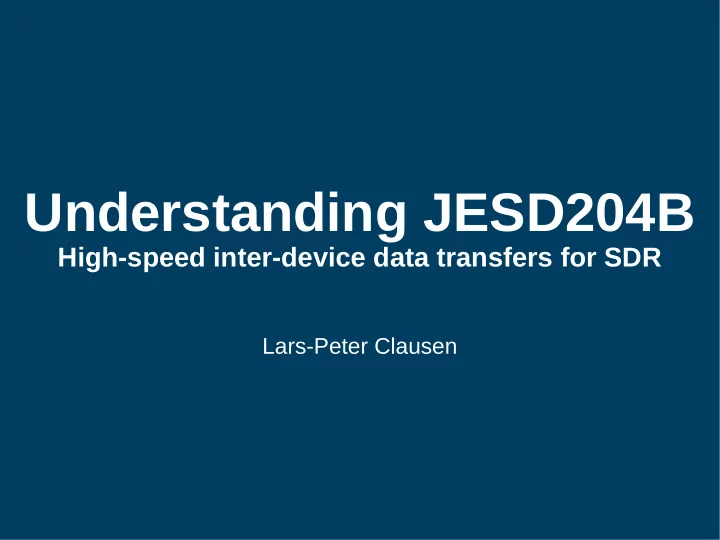

Understanding JESD204B High-speed inter-device data transfers for SDR Lars-Peter Clausen
Introduction
JESD204 Standard ● Designed as high-speed serial data link between converter (ADC, DAC) and logic device – Up to 32 lanes per link – Up to 12.5 Gbps (raw) per lane ● Describes data mapping and framing ● Multi-chip synchronization ● Deterministic latency
Timeline ● 2006: JESD204 – 1 lane, 3.125Gbps ● 2008: JESD204A – Multi-lane, 3.125 Gbps ● 2012: JESD204B – Multi-lane, 12.5 Gbps – Deterministic latency ● Subclass 0, 1, 2 – More flexible clocking scheme
Motivation
Increasing Data Demands ● Increasing channel bandwidth – 802.11ac: 160 MHz, LTE: 5 * 20MHz – > 1GHz at higher bands ● Diversity transmitter/receiver – MIMO, Multi-user ● Direct RF – Move parts of the signal chain into the digital domain – ADC/DAC directly capture/synthesize RF data
Replacing Parallel Buses ● To increase throughput on a parallel bus either increase – Number of pins – Clock rate ● More pins: – Routing issues – Power concerns
Jitter on Parallel Buses ● A parallel bus needs to capture all data lines at the same time ● Complicated by skew and jitter caused by manufacturing and environmental differences – Process, Voltage, Temperature (PVT)
Architecture
Overview
Layers
Converter Device ● Does either A2D or D2A conversion ● Contains one or more converters – All synchronous ● Modern converter devices often include digital processing
Logic Device ● Implements digital signal processing ● Often implemented in a FPGA ● One logic device can interface multiple synchronous converter devices – Multi-point link
Link ● Link consist of multiple independent lanes ● Differential current-mode- logic (CML) signaling ● 8b/10b data encoding ● Embedded clock ● Data scrambling – Optional, but highly recommended
Link/Lane Parameters ● Parameters are used to describe the link and lane configuration Parameter* Description DID Device identification LID Lane identification F Octets per frame K Frames per multi-frame L Number of lanes per converter device N Converter resolution N' Number of bits per sample (recommended to be multiple of 4) SCR Scrambling enabled/disabled HD High-density (Single sample split over multiple lanes) JESDV JESD204 Version (JESD204A, JESD204B) SUBCLASSV JESD204B Subclass (0, 1, 2) * Table is a excerpt of the most important parameters
Deterministic Latency
Latency ● Propagating data over the link takes time – Part of the latency is fixed – Part of the latency depends on manufacturing and environmental conditions (PVT) ● Some systems/algorithms are latency sensitive – Closed-loop-control systems – Radar
Deterministic Latency
Deterministic Latency ● End-to-End (JESD link) Latency is consistent (and deterministic) across PVT variations and from power-on to power-on ● Non-deterministic latency components are not removed, but compensated – Data is buffered before released to the application layer – Release happens at deterministic release opportunities ● Supported by JESD204B subclass 1 and 2
Data Integrity
Error Detection ● 8b10b encoding allows detection of simple errors – Disparity and not-in-table errors ● Frames with errors should be replaced with the previous frame – Most implementations assert an error flag ● No additional data protection – No CRC, FEC, etc.
Data Integrity ● Raw payload data transported over JESD204B link inherently noisy – Upper layers implement forward-error-correction and retransmission ● Link bit-error-rate just needs to be good enough
Alignment Monitoring ● Under certain conditions the last character in a frame/multi-frame is replaced by an alignment control character – These control characters will not appear anywhere else in the datastream – Allows detection of frame or multi-frame misalignment
Software Support
Current Situation ● No common infrastructure ● System integrator has to... – research constraints of all system components – find one configuration that works for all – look-up magic register values for this configuration ● Application developer has to work with provided fixed configuration
libjesd204 (WIP) ● Built-in database of converter device, logic device and clockchip constraints – Programmatic rules establish relationships ● E.g. X = Y / 4 ● System integrator only needs to specify board constraints – E.g. number of connected lanes ● Application developer can dynamically change configuration at runtime – E.g. set samplerate to 500MSPS ● Configuration automatically mapped to register settings
Questions and Answers
Additional References ● Analog Devices JESD204B Survival Guide http://www.analog.com/media/en/technical-documentation/technical- – articles/JESD204B-Survival-Guide.pdf ● M-Labs Open Source JESD204B HDL https://github.com/m-labs/jesd204b – ● FPGA Vendor JESD204B information: https://www.altera.com/jesd204b – https://www.xilinx.com/products/technology/high-speed-serial/jesd204- – high-speed-interface.html
Thanks
Bonus Slides
Available soon https://github.com/analogdevicesinc/ hdl/tree/dev/library/jesd204
Framing ● Samples are mapped into nibble groups – Control bits and padding are added ● Nibble groups are mapped to octets ● Octets are processed per lane
Local Multi-Frame Clock ● Each JESD204B device generates an internal local multi-frame clock (LMFC) – 1-32 frames long ● Beginning of the LMFC is synchronized externally – Subclass 1: SYSREF, Subclass 2: SYNC ● Internal events are synchronized to the LMFC
Link Synchronization ● Receiver asserts SYNC ● Transmitter repeatedly sends /K/ character ● Receiver performs CDC and character alignment ● Receiver de-asserts SYNC ● Transmitter starts sending ILAS and data
Initial Lane Alignment Sequence ● After link synchronization the transmitter sends the (Initial Lane Alignment Sequence) ILAS ● Allows verification of link alignment – Special control character at the start and end of ILAS multi-frame ● Second ILAS multi-frame contains link configuration parameters – Allows to verify configuration and lane mapping
SYSREF ● SYSREF is used as a synchronization signal – In subclass 1 ● Source synchronous to the device clock ● Three modes – Periodic, gapped periodic, one-shot ● LMFC is aligned to SYSREF
Initial Lane Alignment Sequence ● After link synchronization the transmitter sends the (Initial Lane Alignment Sequence) ILAS ● Allows verification of link alignment – Special control character at the start and end of ILAS multi-frame ● Second ILAS multi-frame contains link configuration parameters – Allows to verify configuration and lane mapping
Recommend
More recommend